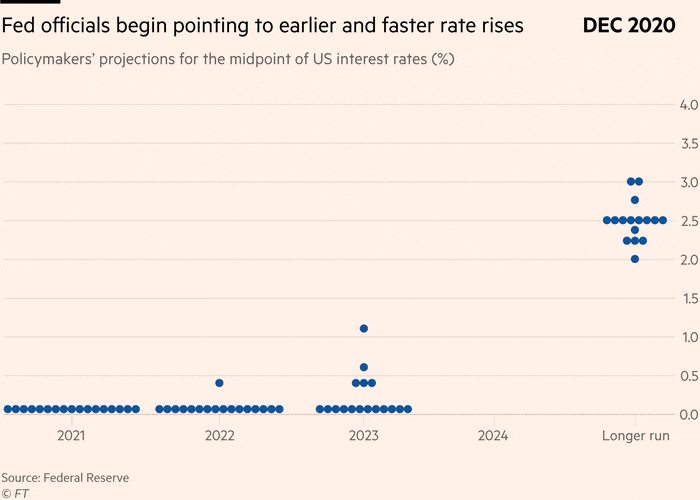[ad_1]
Federal Reserve officials expect to raise interest rates three times next year in a dramatic shift from their projections just three months ago as the US central bank assumes a much more aggressive approach to taming surging inflation.
The more hawkish interest rate forecasts were published alongside a plan to double the pace at which the Fed withdraws or “tapers” the massive bond-buying programme it put in place at the start of the pandemic. It will in January begin cutting purchases by $30bn a month so that the stimulus is removed several months earlier than initially expected.
That would put the Fed on track to stop adding to the size of its balance sheet by the end of March and give it leeway to raise rates soon thereafter.
At the end of its two-day policy meeting on Wednesday, the Federal Open Market Committee kept its main interest rate on hold at the rock-bottom range of 0 to 0.25 per cent, while signalling support for a more assertive approach to tightening policy.
When the so-called dot plot of individual interest rate projections was last updated in September, senior policymakers were evenly split on the prospects of a “lift-off” in interest rates from today’s near-zero levels in 2022.
Now, three increases are expected in 2022, with three more rate rises pencilled in for 2023, followed by two in 2024.

“Supply and demand imbalances related to the pandemic and the reopening of the economy have continued to contribute to elevated levels of inflation,” said Jay Powell, Fed chair, in a press conference following the central bank’s statement.
“These problems have been larger and longer lasting than anticipated, exacerbated by waves of the virus.”
When asked about the possible timing of the first interest rate increase, Powell said he did not expect a “very extended wait” between the end of the asset purchase programme and lift-off.
“The economy is so much stronger now, so much closer to full employment, inflation is running well above target and growth is well above potential,” he said. “There wouldn’t be the need for [a] long delay.”
He added that the Fed held its first discussions about the balance sheet and the possible “sequence of events” at its meeting this week.
The abrupt shift from the Fed follows a string of robust economic data suggesting the labour market is recovering and that inflation is broadening out and at risk of becoming more entrenched.

Powell laid the groundwork for the move at congressional hearings several weeks ago, officially retiring the use of the word “transitory” to describe inflation and signalling that stable prices are essential for a long economic expansion.
The Fed on Wednesday acknowledged that the inflation test for lift-off had been met. It had previously said it would keep interest rates tethered close to zero until it achieved inflation that averages 2 per cent for some time and maximum employment.
The central bank did not set a numeric target for employment, but the recent drop in the unemployment rate to 4.2 per cent suggests progress has been made. Powell said all FOMC participants expect the employment threshold to be reached next year.
The Fed also on Wednesday updated its economic projections, raising the forecast for core inflation — now running at 4.1 per cent — to 4.4 per cent this year, before dipping to 2.7 per cent in 2022. It also lowered the estimate for the unemployment rate to end 2021 at 4.3 per cent while falling next year to 3.5 per cent.
Fed officials lowered their forecasts for economic growth from 5.9 per cent to 5.5 per cent in 2021, and a 4 per cent pace in 2022.
The statement also said that new coronavirus variants pose a risk to the economic outlook, and Powell stressed the uncertainty stemming from the rapid rise of Omicron.
The decision reverberated through financial markets, as investors took the view that the Fed was serious about bringing rising inflation under control and digested the more aggressive pace of tightening planned by policymakers.
Short-term funding markets, including fed funds futures, were pricing in three quarter-point rate rises by the end of next year. That helped push the yield on the policy sensitive two-year Treasury up 0.01 per cent to 0.67 per cent.
“What we’re seeing from the Fed is that they’re beginning the process of re-establishing their credibility,” said Bob Michele, chief investment officer at JPMorgan Asset Management. “In the last year it had come into question as we in the market had watched inflation accelerate with little sign it was going to level off or peak and were bewildered that the Fed was supplying as much accommodation as it was.”
Investors sold out of longer-dated Treasuries, sending the yield on the benchmark 10-year note up 0.02 percentage points to 1.46 per cent.
However, the shift from the Fed did not alter investors’ longer-term views of just how high it could ultimately lift rates. Implied rates on eurodollar futures that mature in late-2023 and beyond fell, a signal that traders did not expect the central bank to raise rates beyond 1.5 per cent in the years ahead.
US stocks advanced, reversing losses registered earlier in the trading day. The blue-chip S&P 500 climbed 1.6 per cent while the technology-heavy Nasdaq Composite gained 2.2 per cent.
“This is a fairly do-no-harm message from the Fed and is probably preferable to the markets than the Fed being completely blind to where we are in the cycle, not doing enough and inflation expectations getting unanchored,” said Jurrien Timmer, the director of global macro at Fidelity Investments. “It is much harder to put the genie back in the bottle.”
Additional reporting by Kate Duguid in New York
[ad_2]
Read More: Fed officials expect three rate rises next year in hawkish pivot on inflation
